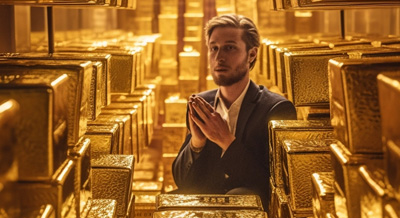Everyone Would Buy Gold If They Knew This
Peter Reagan
 Investors could benefit from more education about gold Investors could benefit from more education about gold
State Street’s chief gold strategist George Milling-Stanley, known among other things for his accurate forecasts on the metal, recently discussed the issue of coverage in financial media. He highlighted some points that suggest gold demand from private investors may be lackluster simply due to a lack of knowledge.
A survey done by State Street showed that only 20% of respondents had a gold allocation. But a more telling response came in the form of one third of respondents saying they don’t know enough about how to invest in gold.
For all that’s said about gold going mainstream over the last few years, it seems that the average investor is still highly under-informed about gold. Certainly, that is true if the barrier to entry is not even knowing how to form an allocation. And we already know why your financial advisor won’t recommend physical precious metals…
Even those who have invested in gold might not be familiar with technicalities that are extremely favorable for gold. For example, how many gold investors know that gold has been outperforming in both the Swiss franc and the British pound, almost as if to round up the “safe-haven” currency basket?
Milling-Stanley added:
The main message from the analysts is that the future of gold investment seems to be safe. That is very, very good news. There is a job for the industry at large to do in terms of educating investors and potential investors.
And how many are aware that analysts now expect 21 out of 30 top central banks to start cutting rates in 2024? If gold rose by more than 10% this year in the middle of a hiking cycle, it seems a given that explosive price action is in the books once easing begins.
Notably, the investors polled by State Street are all presumably more familiar with economics than an average American citizen. We can therefore conclude that everyday American families are even less familiar with how easy it can be to invest in gold, and how beneficial.
We’re doing our best, every single day, to educate everyone about the benefits of diversifying with gold. But we’re David compared to the manpower and marketing budgets the Goliaths of the financial industry can deploy. We’ll keep fighting the good fight, though, and reach as many Americans as we can.
Russia’s central bank buying gold again while also being a primary supplier
The story of Russian gold seems to somehow become more interesting by the day, and it was never a dull one to begin with. Last year’s invasion had Russian gold forbidden by NATO (along with owning any business interests in Russia, or even rubles). This was an attempt to strangle Russia’s economy to damage its ability to maintain its occupation of Ukraine.
Here’s the thing: Sanctions don’t work because they create new markets.
The United Arab Emirates (UAE) is one nation that’s happy to buy gold with a Russian refiner’s assay mark. As of the first quarter, the UAE imported a massive 75.7 tons of gold. “Massive” seems appropriate considering, just two years back, the UAE bought just one ton of imported gold.
Russia is now the UAE’s main gold provider, and that’s just the start of curiosities involving the nation and the precious metal. Russia recently released data going back to February 2022 showing increased gold holdings of 28 tons, with 3 tons bought in August as of latest counting. But analysts remain unsatisfied.
World Gold Council chief market strategist John Reade said:
I’m glad to see that the history of Russia’s #gold holdings has now been backfilled. It does beg the question of where the rest of Russia’s production has gone – at about 300t per annum this is far more than domestic demand or CBR’s reported purchases.
We can assume that Russia is both under-reporting domestic demand and selling to plenty of other nations besides the UAE, China and Turkey…
Then there’s the whole issue of Russia needing something to prop up its currency, a problem that can easily be solved with a gold standard (and maybe nothing else).
Daniel McCarthy, strategist at DailyFX.com, suspects China and Russia downplayed the gold-backed BRICS currency story, for now. So they can surprise the world with it later. After all, Russia assumes BRICS chairmanship on January 1. They’re already teasing a major currency announcement by Putin in October 2024.
McCarthy observed:
On a recent trip to Western Australia, one the largest physical gold-producing regions globally, a number of contacts highlighted that almost every ounce of the yellow metal currently being dug out of the ground was being put on a ship to China. Such anecdotes of other BRIC members taking similar actions have been reported elsewhere.
Keeping in mind that Australia, China and Russia are also the top producers of gold, it might be the case that gold hoarding has been a feature of the price action of late. [emphasis added]
Remember: China and Russia are the world’s #1 and #2 gold mining nations, producing 20% of the global gold production in 2022. (Australia is #3.) Both the “R” and the “C” in BRICS are stockpiling gold. Just another step toward dedollarization? Reserves to back a new BRICS currency?
Both?
Only time will tell. What’s clear, though, is that the global demand for gold has rarely been greater.
The London Metals Exchange and Chinese gold prices
Who owns the London Metals Exchange (LME)? It has to be Britain, right?
As it turns out, the Hong Kong Exchanges and Clearing (HKEC) bought it for just $2.2 billion way back in 2012. When it did so, it promised to support Britain with a favorable connection to China (in case someone believed the HKEC and China are separate entities).
The Asian nation has since been embroiled in (of all things) a nickel scandal. We haven’t reported on the “nickel curse” previously as it doesn’t affect precious metals at all, but it is quite interesting to see just how many games are played behind the scenes in commodities markets. If you’re not a metallurgist, you may be interested to note that nickel is more crucial even than steel as a war metal.
This analysis mentioning how China wants a bigger say in the pricing of commodities more generally, including gold. See, assessing China’s fair-trade policies also describes how it manipulated the nickel market to spike prices to a record high. This undermined the LME’s clout and status, but China only cared so much:
That’s probably why the Shanghai Futures Exchange (ShFE) is now planning its own nickel futures contract for international use.
If that name sounds familiar, that’s probably because the Shanghai Gold Exchange has long been understood to view the LBMA as a rival. These days, China needs this say for more reasons other than global expansion.
The story of a thriving Chinese economy appears to be winding down, and the yuan faces structural weakness that isn’t even relatedto inflation. This is why Chinese gold premiums have spiked so high, but also why China is encouraging its citizens to invest in gold and banning most other forms of capital flight.
If we are to guess, is China preparing to ditch the yuan on some level and replace it with gold, in doing so creating a currency more appealing than any unbacked paper currency? Whether this is to take effect through a gold-backed yuan, a gold-backed BRICS currency or something else makes for intriguing thought experiments.
I believe the first nation to adopt a fully-convertible gold-backed currency would reap massive global benefits… It’s possible China and Russia might not be willing to wait for the rest of BRICS to get on board, and are each racing to back their own currencies…

Peter Reagan is a financial market strategist at Birch Gold Group. As the Precious Metal IRA Specialists, Birch Gold helps Americans protect their retirement savings with physical gold and silver.
www.newsmax.com
| ![[Most Recent Quotes from www.kitco.com]](http://www.kitconet.com/images/live/s_gold.gif)
![[Most Recent USD from www.kitco.com]](http://www.weblinks247.com/indexes/idx24_usd_en_2.gif)
![[Most Recent Quotes from www.kitco.com]](http://www.kitconet.com/images/live/s_silv.gif)


